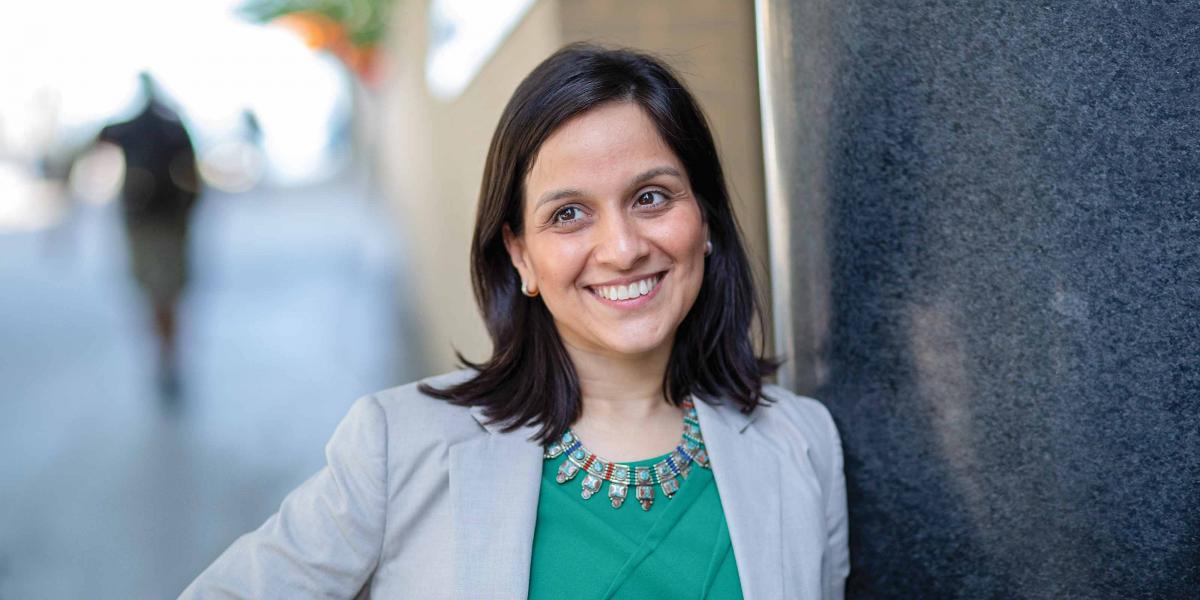Healthcare’s Digital Future
Smisha Agarwal assesses the immense potential—and possible pitfalls—of digital health technologies.
After earning dual MPH/MBA degrees from the Bloomberg School and the Carey Business School in 2009, Smisha Agarwal, PhD, returned to a mobile phone revolution in her native India. It seemed that everyone, even in the poorest villages, used a phone to get cricket
match updates.
Agarwal had a different use in mind for phones when she launched Global Health Bridge. The nonprofit developed a platform to track pregnancies based on data collected on mobile phones by community health workers.
Agarwal, an assistant professor in International Health, has since become a global leader in digital health research, interventions, and evaluation in low-resource settings. Here, she considers the digital health space with a view from the frontlines.
You've been described as the School’s first faculty for digital health. How do you interpret that description?
I use digital health tools in my work, but I don’t think of myself as somebody who works exclusively on digital health. As one of the early arrivals to the field, I have several leadership roles in the space, but the overall goal is to improve the health of women and children.
In April, WHO released its first digital health guideline for health system strengthening, a project that you worked on with JHSPH colleagues. Why is this work important?
Over the last decade, there has been a staggering amount of investment in digitizing health care, whether it means using mobile devices for data collection, a systems-wide digitization approach where health care workers are using mobile devices to deliver services, or a program to send informational messages to pregnant women.
The guideline provides a roadmap for governments, donors, and researchers to strengthen and scale these health programs. [International Health associate professor Alain Labrique, PhD ’07, MHS ’99, MS, co-chaired the guideline committee.] It includes insights on appropriate adaptations to digital interventions based on the context and also identifies significant opportunities to address knowledge gaps with future research.
Where are some of those gaps?
Gaps exist in understanding how we can effectively integrate these tools with existing health systems, and whether they are more cost effective than traditional ways of delivering health care. Understanding how the use of digital tools may affect inequities in access to health services is another area: Do they improve access for remote populations or divert resources from those without mobile phones?
How are digital technologies being used at the point of care?
With mobile-based clinical decision-support tools, health care workers can provide more comprehensive services.
A project we did in partnership with FHI360 and DTree International in Tanzania focused on providing family planning counseling and screening for STDs to women in the community. If a health care worker goes through a series of questions with the client, the information feeds into a database that triggers an algorithm for appropriate counseling and referral.
In many low- and middle-income countries there is a dearth of trained health care providers, so we can “task-shift” some of the less complex tasks of providing preventive services and triaging low-severity illnesses to community health workers.
The data captured during such service encounters might be used at a population level to prioritize health care resources using machine learning. With sufficient data, we could develop algorithms to predict clients or populations with a higher risk for poor outcomes and divert health services accordingly.
How can digital tools be used to optimize drug supply chains?
Often, community health providers prescribe simple drugs, such as oral antibiotics for a sick child. In remote communities, the provider and the closest health care facility may not have the drugs readily available, resulting in treatment delays.
A potential solution is cStock, a project in Malawi led by JSI [John Snow Inc.]. Community-level providers regularly send texts on their drug supply needs to a central health facility. The system collates the data on a centralized dashboard and sends a report to the district manager who can ensure that appropriate supplies become available.
Are there downsides or potential harms related to the growth of digital health?
One is the opportunity cost. If governments invest in these technical systems—which are, at the outset, more expensive than paper systems—they are taking limited resources away from more established programs and redirecting them to a more experimental approach.
There’s also the potential for gender inequity. In South Asia especially, it’s the men in the household who have phones, and a lot of digital health services around pregnancy and newborn care may not get to the women who are the targeted recipients.
There was some indication in a review that was done for the [WHO] guideline of an increase in domestic violence against women who received text messages about sexual and reproductive health, as well as fear of inadvertent disclosure of HIV status.
And in countries where there aren’t proper protocols and regulations around data security and data privacy, how can that affect patients?
How do you see digital health tools transforming public health in the next 25 years?
In the resource-constrained settings where I work, digital tools can potentially leapfrog over significant constraints in health infrastructure. Point-of-care digital tools can put real-time data at your fingertips. Appropriate use of data analytics and machine learning can result in efficiencies in allocating resources and targeting high-risk patients. Providers with limited training may use such tools to receive more training remotely or be guided through a patient encounter. It is effectively changing the health outcomes for the poorest and helping us achieve the vision of universal health care.
Digital systems are facilitating the process of counting newborn babies and newborn deaths, which continues to be a huge problem that results in inequities. If you’re not counted, you don’t have access to services that your country provides. It’s really a gateway to exerting your rights as a citizen.
